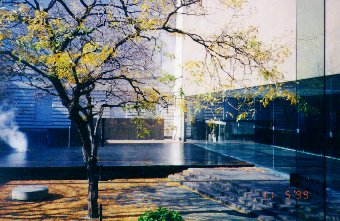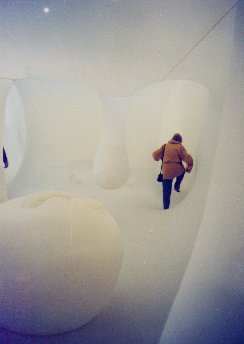|
The Carnegie Museum of Art hosts an International art exhibit every 3 years, thus bringing to our citizenry a taste of the latest trends and names in the International Art world. It makes the viewer reflect on just exactly what Art is, and what it does to enhance our lives.
I have found that the experience changes with the group that accompanies me: by myself I explore, react, consider, like a remote camera. With an intellectual companion, we examine and discuss, and pry into the motives of the artist. When I go with my playful, experimental friends, the installations become a happy experience, a foil for our whimsey, unquestioned, accepted as they are. Accompanied by someone who is afraid of this "new-fangled" stuff, the experience is strained, unpleasant, and I apologize and wish to be gone. The International 1999-2000 has several installations in it; and some of them are excellent.
My first trip to this show was the members preview: more officials and dignitaries there than general public, and many of them with cameras. The guards were less rigid in their insistance we not take pictures, or I would have no visuals for this page!
Upon entering the museum from the parking lot, one encounters an installation of 17 walk-in boxes built up the stairwell and across the entry lobby. (by Suchan Kinoshita, no title) They look like a series of out-houses! Rather, they are in-houses; for in each we are called upon to contemplate a different vista, both real and unreal. For the real, the box acts as a frame, directing us to "look this way" at something we might otherwise just pass by, unaware. |

We look out on a beautiful reflecting pool built for the show by Olafur Eliasson, of water and steam. The steam jets change direction with the air currents, the ripples on the water surface add a texture. Later in the winter it will include snow and ice as elements.
 |
 My absolute, all time favorite installation is one called Nude Plasmic, and it was created by a Brazilian named Ernesto Nato. I call it the "womb room". It is a room constructed of a stretch fabric, suspended from ceiling, walls and floor of its room in the museum. Visitors are invited to enter this room, but must first remove shoes, belts, purses or anything else that might stick and cause the fabric to tear or run. (there is a guard there to guard your discarded stuff!)
My absolute, all time favorite installation is one called Nude Plasmic, and it was created by a Brazilian named Ernesto Nato. I call it the "womb room". It is a room constructed of a stretch fabric, suspended from ceiling, walls and floor of its room in the museum. Visitors are invited to enter this room, but must first remove shoes, belts, purses or anything else that might stick and cause the fabric to tear or run. (there is a guard there to guard your discarded stuff!)You enter through a vaginal like opening, into a room that is soft, quiet, misty. You are removed from the harsh realities of life. Bulbous appendages hang down from the roof of this room, or bump up from the floor, there are two tunnels that take you into a smaller space. Walking is slow and considered, as one would go through high, but loosely packed snow. Sound is muffled, as in snow. I would love to curl up in the far end of this piece, but there are others, waiting to get in. And with such a soft floor, I'd never rise again!
|
|
Not all of the installations are to be found at the Carnegie Institute. 6 are located in the Mattress Factory, a museum devoted to installation art, on the north side. The Mattress Factory is a long distance from the Carnegie Institute, and hard to find, but there is a shuttle bus running between these two museums, plus the Andy Warhol Museum and the Pgh. History Museum. This makes museum going much easier, especially for the out-of-town visitor. (Parking, by the way, is ample and moderately priced at the Carnegie Museum; ample and expensive at the History Museum, free at the Mattress factory but the lot is small and if it is full you are out of luck! There is little on-street parking and the neighborhood is questionable. Parking is non existant at the Warhol.)
|